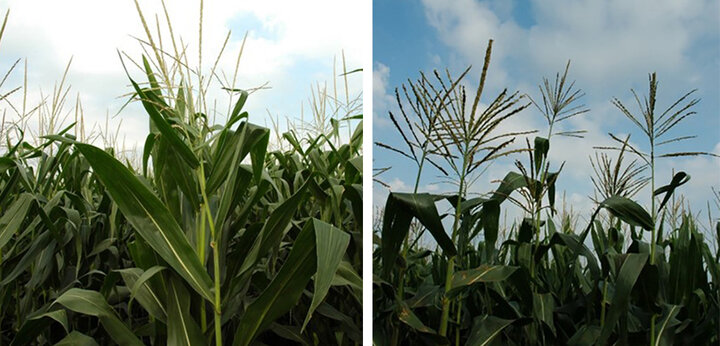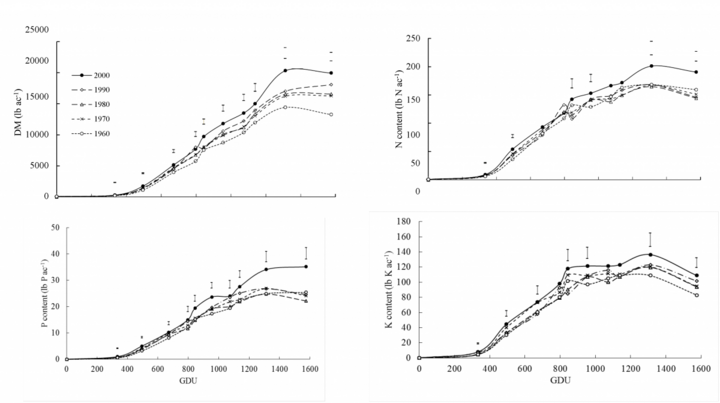Roger W. Elmore - Extension Cropping Systems Agronomist, University of Nebraska-Lincoln
John E. Sawyer - Extension Soil Fertility Specialist, Agronomy, Iowa State University
Matt J. Boyer - Former Graduate Student, Agronomy, Iowa State University
Krishna P. Woli - Former Post Doctorial Scientist, Agronomy, Iowa State University

You’d think that 70 plus years after our predecessors had a basic understanding of corn development we’d understand it completely. Not true! For example, we know that hybrid productivity has increased dramatically since the middle of the 20th Century. Hybrids grown from the 1960s to the 2000s look dramatically different, as you might guess (Figure 1). But beyond that, their nutrient content, concentrations, and partitioning into plant parts have changed as well. We explore those changes in this article.
Our work on this project all started with a question. The go-to source for corn growth and development for many corn agronomists trained in the last half of the twentieth century was the definitive publication, How a Corn Plant Develops by Richie et al, (1982). John J. Hanway published the first iteration of this classic in 1966 and reprinted it in 1971. Richie et al.’s version of this work had the same foundation first laid by Hanway. Would modern hybrids grow in the same way?
This question was the genesis of a 12-year project resulting first in the Extension publication of Corn Growth and Development (Abendroth et al., 2011a,b) and then, an M.S. thesis by M.J. Boyer (2013) and several publications in the Agronomy Journal, (Woli et al., 2016, 2017, 2018). We set up a comprehensive investigation to answer this question. This article and talk at the Nebraska Crop Management Conference attempts to summarize that work.
What We Did
We planted two hybrids representative of 1960, 1970, 1980, 1990, and 2000 era decades – all were adapted to Central Iowa ― 108- to 114-day hybrids.
We evaluated the response to N fertilizer of a single hybrid from each era at five N rates from 0 to 200 pounds N acre-1 (0 to 224 kg N ha–1) to determine changes in N response. We measured dry matter production (DM) and dissected plants from the hybrids at 10 times during each of two growing seasons.
What We Found — In Part

Whole Plant DM and Nutrient Accumulation
- Era hybrids differed in DM and nutrient accumulation; differences in primary, secondary, and micronutrient content were mainly related to increased DM production with the more recent hybrids (Figure 2).
- Lower nutrient concentrations moderated nutrient content in the most recent hybrids.
- Absolute DM production and nutrient content were greater with the most recent hybrids.
Nutrient Partitioning – 1960 and 2000 Era Hybrids
- Similar DM, primary, secondary, and micronutrient accumulation patterns occurred for 1960 and 2000 era hybrids.
- The greater modern hybrid nutrient content of most plant components was mainly due to greater DM.
Era Hybrid Responses to N
- Nitrogen use efficiency (NUE) generally increased with more recent hybrids.
- Grain yield increased 65% and total plant biomass increased 43% from 1960 to 2000.
- Total plant N uptake increased only 19% and across N rates was only higher for the 2000 era hybrid.
Conclusions
Corn hybrids have indeed changed significantly since 1960! In our study, yield increased 65% and plant DM 45%. It is apparent that higher primary, secondary and micronutrient content in newer hybrids was driven mainly by increases in DM and associated nutrient uptake rates. This occurred as yield potentials increased.
Nutrient accumulation patterns were similar across the eras. Grain N in our modern hybrids was 24% less than those of the 1960s.
Yield potential and not genetic development for nutrient use timing has driven nutrient use over the decades included in this study.
Corn hybrid development across the 50-year period improved both productivity and nitrogen use efficiency. No significant change in the N rate that maximized yield occurred.
As overall DM production and yield potential increases in the future, we must closely watch corn primary, secondary, and micronutrient concentration and uptake in new hybrids.
Access to newer hybrid plant component macronutrient concentrations like those we’ve provided in these publications will also help us estimate global corn nutrient use.
References
Abendroth, L.J., R.W. Elmore, M.J. Boyer, and S. K. Marlay. 2011a. Corn Growth and Development. PMR 1009. Iowa State University Cooperative Extension Service, Ames Iowa.
Abendroth, L.J., R.W. Elmore, M.J. Boyer, and S. K. Marlay. 2011b. Crecimineto y desarrollo del maíz. PMR 1009S. Iowa State University Cooperative Extension Service, Ames Iowa.
Boyer, M.J. 2013. Dry Matter and nutrient accumulation in corn hybrids from the 1960s to 2000s. M.S. Thesis, Iowa State University, Ames IA.
Richie, S.W., J.J. Hanway, and G.O. Benson. 1986. How a corn plant develops. Spec Rep 48. Iowa State University Cooperative Extension Service, Ames Iowa.
Woli, K.P., M.J. Boyer, R.W. Elmore, J.E. Sawyer, L. J. Abendroth, and D.W. Barker. 2016. Corn era hybrid response to nitrogen fertilization. Agronomy Journal 108: 473-486.
Woli, K.P., J.E. Sawyer, M.J. Boyer, L.J. Abendroth, and R.W. Elmore. 2017. Corn era hybrid dry matter and macronutrient accumulation across development stages. Agronomy Journal 109:751-761.
Woli, K.P., J.E.Sawyer, M.J. Boyer, L.J. Abendroth, and R.W. Elmore. 2018. Corn era hybrid macronutrient and dry matter accumulation in plant components. Agronomy Journal 110: 1648-1658.
Woli, K.P., J.E.Sawyer, M.J.Boyer, L.J. Abendroth, and R.W. Elmore. 201_. Corn era hybrid nutrient accumulation: secondary and micronutrients. In co-author review, September 2018.

